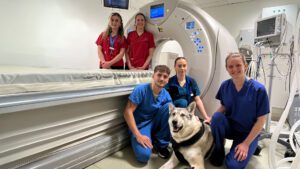Objective
To characterise the symptomatic phenotype of Chiari-like malformation (CM), secondary syringomyelia (SM) and brachycephaly in the Cavalier King Charles Spaniel...
Methods
This retrospective study, based on a previous quantitative analysis in the Griffon Bruxellois (GB), used 24 measurements taken on 130 T1-weighted MRI of hindbrain and cervical region. Associated brachycephaly was estimated using 26 measurements, including rostral forebrain flattening and olfactory lobe rotation, on 72 T2-weighted MRI of the whole brain. Both study cohorts were divided into three groups; Control, CM pain and SM and their morphometries compared with each other.
Results
Fourteen significant traits were identified in the hindbrain study and nine traits in the whole brain study, six of which were similar to the GB and suggest a common aetiology. The Control cohort had the most elliptical brain (p = 0.010), least olfactory bulb rotation (p = 0.003) and a protective angle (p = 0.004) compared to the other groups. The CM pain cohort had the greatest rostral forebrain flattening (p = 0.007), shortest basioccipital (p = 0.019), but a greater distance between the atlas and basioccipital (p = 0.002) which was protective for SM. The SM cohort had two conformation anomalies depending on the severity of craniocervical junction incongruities; i) the proximity of the dens (p
Conclusion
Morphometric mapping provides a diagnostic tool for quantifying symptomatic CM, secondary SM and their relationship with brachycephaly. It is hypothesized that CM pain is associated with increased brachycephaly and SM can result from different combinations of abnormalities of the forebrain, caudal fossa and craniocervical junction which compromise the neural parenchyma and impede cerebrospinal fluid flow.
Research authors
A Tauro AK McFadyen C Cross C. Rusbridge CJ Driver J Jovanovik RM La Ragione S Griffiths SP Knowler Z Kibar











